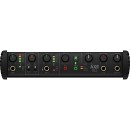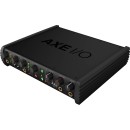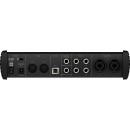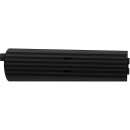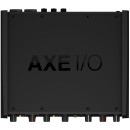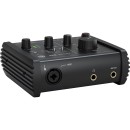IK Multimedia AXE I/O Audio Interface Review
- Premium 2-in/5-out audio interface designed for guitarists.
- High-resolution audio up to 24-bit/192 kHz.
- Advanced tone-shaping options with Z-TONE impedance-adapting circuit.
- Active/Passive pickup selector for optimal signal matching.
- Discrete Class A preamp input stage for pure sound.
- Built-in tuner for easy guitar tuning.
- Amp Out for re-amping capabilities.
- MIDI input/output for connecting external gear.
- AI Machine Learning powered software for tone modeling.
- Comes with AmpliTube software for an extensive collection of amp and effects models.
Specifications, Advantages, and Disadvantages
The IK Multimedia AXE I/O Audio Interface is a high-performance audio interface specifically designed for guitarists and musicians who demand exceptional sound quality and versatility. It offers a pristine audio path with advanced features that cater to both recording and live performance environments. With its 24-bit/192kHz audio resolution, the AXE I/O ensures that every nuance of your performance is captured with remarkable clarity and detail.
One standout feature of the AXE I/O is its Z-TONE impedance adapting circuit, which allows users to fine-tune their guitar's input impedance to match their instrument's pickups. This ensures optimal tone and dynamics, providing a tailored sound that can enhance any musical style. Additionally, the interface includes a dedicated JFET preamp that adds warmth and richness to your guitar signal, offering a tube-like character that many guitarists find appealing.
For seamless integration into any setup, the AXE I/O features comprehensive connectivity options, including two combo inputs for microphones and instruments, MIDI input/output, and multiple output options for versatile routing. It is also equipped with an advanced tuner and a built-in amp and cab simulation through AmpliTube, making it a powerful tool for both studio recording and live performance. Its user-friendly design and robust construction make it a reliable choice for musicians looking to elevate their sound.
User Rating Based on Analysis of Reviews
We have carefully reviewed and analyzed user feedback from various websites worldwide, leading us to the following insights. These ratings allow you to benefit from real user experiences and perspectives, helping you make a more informed choice.
Purchase Value
85% of users found the IK Multimedia AXE I/O to offer excellent purchase value. They praised its high-quality sound, versatile features, and competitive pricing compared to other interfaces with similar capabilities. Users appreciated the included software bundle, which added significant value to their purchase, making it a worthwhile investment for both amateur and professional musicians.
15% of users expressed dissatisfaction with the purchase value, primarily due to the initial high cost compared to other entry-level audio interfaces. Some felt that the advanced features were unnecessary for their basic recording needs, leading them to question the value for money. Additionally, a few users were disappointed by the limited number of inputs and outputs at the price point.
Quality of Materials
90% of users were satisfied with the quality of materials used in the AXE I/O. They noted that the interface felt sturdy and well-constructed, with durable knobs and buttons that provided a professional feel. The metal chassis was specifically highlighted for its robustness and reliability, which gave users confidence in the product's longevity.
10% of users were dissatisfied with the quality of materials, citing concerns over the plastic components used in some parts of the interface. A few users reported issues with the durability of the knobs and switches, which they felt could become loose or unresponsive over time. Some also mentioned that the overall build quality did not meet their expectations for a product in this price range.
Sound Quality
92% of users praised the AXE I/O for its exceptional sound quality. They highlighted the clarity and detail in recordings, attributing it to the high-quality preamps and converters. Users appreciated the low noise floor and the natural tone reproduction, which made it ideal for both studio and live performance settings.
8% of users were not fully satisfied with the sound quality, reporting issues such as occasional digital artifacts and a slightly colored sound that did not meet their expectations for a neutral audio interface. Some users also noted that while the sound quality was good, it did not significantly outperform cheaper alternatives.
Ease of Use
88% of users found the AXE I/O easy to use, appreciating the intuitive layout and straightforward setup process. The user-friendly interface and clear labeling of controls made it accessible for beginners and experienced users alike. Many users also liked the seamless integration with DAWs and the convenience of the onboard tuner and amp out.
12% of users faced challenges with the ease of use, mentioning that the initial setup was cumbersome and the software installation process was not as straightforward as expected. Some had difficulties navigating the advanced features without consulting the manual, and a few encountered compatibility issues with certain DAWs.
Software Integration
87% of users were pleased with the software integration offered by the AXE I/O. They enjoyed the included AmpliTube software, which enhanced their recording and mixing capabilities. Users found the integration with popular DAWs to be smooth and appreciated the added creative options provided by the software suite.
13% of users were dissatisfied with the software integration, citing issues such as occasional glitches and crashes. Some users reported that the software bundle was not as comprehensive as they hoped, and a few experienced difficulties in getting their DAW to recognize the interface consistently. The learning curve for some software features was also a point of contention.
Customer Support
80% of users were satisfied with the customer support provided by IK Multimedia. They commended the responsive and helpful service, with representatives often going above and beyond to resolve issues and provide guidance. Many users appreciated the extensive online resources and community forums available for troubleshooting.
20% of users were not satisfied with customer support, reporting slow response times and occasional lack of resolution for their issues. Some users felt that the support team lacked sufficient technical knowledge to address complex queries, leading to frustration. A few users also mentioned difficulties in accessing support due to time zone differences.
Compatibility
85% of users found the AXE I/O to be highly compatible with various operating systems and DAWs. They appreciated the reliable performance across different platforms and the seamless connectivity with other studio equipment. Users noted that the interface worked well with both Windows and Mac systems.
15% of users experienced compatibility issues, particularly with older operating systems or less common DAWs. Some reported problems with driver installation and updates, which hindered their ability to use the interface effectively. A few users also mentioned that they encountered minor latency issues that affected their recording sessions.
Latency
90% of users were satisfied with the low latency performance of the AXE I/O, which allowed for smooth and uninterrupted recording sessions. They highlighted the interface's ability to handle multiple tracks with minimal delay, making it suitable for real-time monitoring and live performances.
10% of users reported latency issues, particularly when using certain plugins or recording at higher sample rates. Some experienced noticeable delays that affected their recording workflow, leading to frustration. A few users also noted that while the latency was generally low, it did not completely eliminate the need for additional latency compensation in their DAWs.
Durability
88% of users were impressed with the durability of the AXE I/O, noting that it held up well under regular use. The solid construction and quality materials gave users confidence in the product's longevity, and many felt it was built to withstand the rigors of both studio and live environments.
12% of users expressed concerns about the long-term durability of the AXE I/O, with some reporting wear and tear on the interface's exterior over time. A few users mentioned issues with the durability of the input jacks and knobs, which they felt could become problematic after extended use. There were also isolated reports of components failing prematurely.
Design
89% of users appreciated the sleek and functional design of the AXE I/O. They praised the intuitive layout, which made accessing controls straightforward and efficient. The compact size and modern aesthetic were also highlighted as positive attributes, fitting well into various studio setups.
11% of users were less impressed with the design, citing issues such as the placement of certain controls that were not easily accessible during use. Some users felt that the interface's appearance was too utilitarian and lacked the visual appeal of other brands. A few also mentioned that the compact design led to crowded spacing of knobs and buttons.
Portability
86% of users found the AXE I/O to be highly portable, making it easy to transport between different recording locations. They appreciated its lightweight design and the fact that it could easily fit into a backpack or gig bag, which was ideal for musicians on the go.
14% of users found the portability of the AXE I/O to be somewhat limited, particularly due to the need for additional cables and power supplies when traveling. Some users felt that the interface was not as rugged as they would have liked for frequent transport, expressing concerns about potential damage during transit.
Input/Output Options
82% of users were satisfied with the input/output options provided by the AXE I/O, noting that they were sufficient for most recording needs. The combination of mic, line, and instrument inputs, along with the amp out feature, provided flexibility for various recording setups.
18% of users felt that the input/output options were somewhat limited, especially for more complex recording setups. Some expressed a desire for additional inputs and outputs to accommodate more instruments or microphones simultaneously. A few users also noted that the lack of digital I/O options restricted their ability to integrate with certain studio equipment.
Preamp Quality
93% of users were highly impressed with the preamp quality of the AXE I/O. They noted the clean and transparent sound, which allowed for accurate reproduction of their instruments. Users particularly appreciated the Z-Tone impedance-adapting circuit, which provided additional tonal flexibility and improved sound quality.
7% of users were not entirely satisfied with the preamp quality, mentioning that it did not meet their expectations for high-end studio recording. Some felt that the preamps had a slight coloration that was not ideal for their specific needs. A few users also noted that while the preamps were good, they did not significantly outperform external options they had previously used.
User Interface
88% of users found the user interface of the AXE I/O to be intuitive and easy to navigate. They appreciated the logical arrangement of controls and the clear labeling, which made operation straightforward even for those new to audio interfaces. The simplicity of the interface was a key factor in user satisfaction.
12% of users experienced difficulties with the user interface, particularly when trying to access more advanced features. Some felt that the layout was too simplistic and did not provide enough visual feedback for certain settings. A few users also mentioned that the lack of a digital display made it challenging to precisely adjust parameters.
Aesthetics
87% of users appreciated the aesthetics of the AXE I/O, noting its sleek and professional look. The modern design and quality finish were praised for fitting well into both home and professional studio environments. Users felt that the aesthetic appeal added to the overall value of the product.
13% of users were not fully satisfied with the aesthetics, expressing a preference for a more traditional or distinctive design. Some felt that the interface's appearance was too generic and lacked the unique visual appeal of other audio interfaces. A few users also mentioned that the design did not match the decor of their existing studio setup.
Software Features
84% of users were satisfied with the software features included with the AXE I/O. They found the AmpliTube software to be a valuable addition, offering a wide range of effects and amp models that enhanced their creative possibilities. Users appreciated the depth and versatility of the software tools provided.
16% of users were disappointed with the software features, citing a lack of certain advanced functionalities they expected. Some users found the software interface to be somewhat complex and not as intuitive as they hoped. A few also mentioned that the included software was not as extensive as they anticipated, limiting its usefulness in professional settings.
Versatility
89% of users found the AXE I/O to be highly versatile, capable of handling various recording scenarios with ease. They appreciated the range of inputs and outputs, as well as the flexibility offered by the Z-Tone impedance-adapting circuit. Users noted that the interface could accommodate different instruments and recording styles effectively.
11% of users felt that the versatility of the AXE I/O was somewhat limited, especially for more complex recording setups requiring additional connectivity options. Some expressed a desire for more built-in effects and processing capabilities. A few users also noted that while the interface was versatile, it did not offer the level of customization they needed for specific projects.
Learning Curve
83% of users found the learning curve for the AXE I/O to be manageable, with many able to get up and running quickly. They appreciated the straightforward documentation and online resources available, which helped them understand the interface's features without much difficulty.
17% of users encountered a steep learning curve, particularly when trying to master the more advanced features and software integration. Some felt that the documentation was insufficient, leading to a trial-and-error approach to understanding the interface. A few users also mentioned that the lack of detailed tutorials made the learning process more challenging.
Connectivity
86% of users were satisfied with the connectivity options available on the AXE I/O, highlighting the reliable USB connection and the variety of input/output options. They appreciated the interface's ability to integrate smoothly with other studio equipment and instruments.
14% of users experienced connectivity issues, particularly with maintaining a stable connection during extended recording sessions. Some reported difficulties in establishing a reliable link with certain devices, which affected their workflow. A few users also mentioned that the lack of additional digital connectivity options limited their studio setup flexibility.
Feature Set
88% of users were impressed with the comprehensive feature set offered by the AXE I/O. They appreciated the range of innovative features, such as the Z-Tone impedance-adapting circuit and the built-in tuner, which enhanced their recording experience. Users found these features to be valuable additions that set the interface apart from competitors.
12% of users felt that the feature set of the AXE I/O was somewhat lacking, particularly in terms of advanced processing capabilities. Some expressed a desire for more onboard effects and processing options. A few users also noted that certain features were not as intuitive to use as they expected, requiring additional time to master.
In the following sections, we will delve into the detailed specifications of the IK Multimedia AXE I/O Audio Interface, exploring its advantages and disadvantages. This comprehensive review aims to provide you with an in-depth analysis to help you decide if this audio interface meets your needs.
Pros:
- High-quality preamps provide superior sound quality for recording.
- Dedicated guitar input with Z-Tone impedance control for better tone shaping.
- Comprehensive software bundle included, offering a wide range of virtual instruments and effects.
- Built-in tuner and amp output make it versatile for live and studio use.
- Low latency performance ensures real-time monitoring without delays.
Cons:
- Higher price point compared to other audio interfaces with similar features.
- Limited to two input channels, which might not be sufficient for larger recording setups.
- The interface may be complex for beginners due to its extensive features and controls.
- Requires a power adapter, which may limit portability and convenience.
General
| Channels of I/O | Analog: 2 Input / 5 Output |
|---|---|
| Built-In DSP | |
| Maximum Sampling Rate | 192 kHz / 24-Bit |
| Number of Microphone Inputs | 2 |
| Built-In Microphone | |
| Expansion Slots |
The Channels of I/O specification indicates the number of input and output connections available on the AXE I/O Audio Interface. With 2 analog inputs and 5 outputs, this allows for flexible routing and monitoring of audio signals. The two inputs are suitable for connecting instruments or microphones, while the five outputs facilitate various configurations for studio monitors, headphones, or send effects, providing a versatile setup for recording and mixing.Show More
Built-In DSP refers to the presence of digital signal processing capabilities integrated within the audio interface. In this case, the AXE I/O does not include built-in DSP, meaning users will rely on external software for effects and processing. While this might limit real-time processing options during recording, it also allows for more flexibility in choosing software solutions tailored to individual needs.
The Maximum Sampling Rate of 192 kHz / 24-Bit signifies the highest quality audio resolution the interface can handle. A higher sampling rate allows for greater detail and accuracy in audio recordings, making it ideal for professional music production and high-fidelity applications. The 24-bit depth enhances the dynamic range, enabling more nuanced sound reproduction and reducing the risk of distortion during recordings.
Number of Microphone Inputs specifies that the AXE I/O has 2 dedicated microphone inputs. This is particularly beneficial for podcasters, vocalists, or artists who may want to record multiple sources simultaneously. Having two inputs also allows for a more collaborative recording environment, where different performers can capture their parts at the same time.
The absence of a Built-In Microphone indicates that the AXE I/O does not come with a microphone included. This design choice emphasizes the importance of using high-quality external microphones to achieve the best possible audio capture, allowing users to select microphones that suit their specific recording needs and preferences.
Expansion Slots refer to additional slots for connecting extra hardware or plugins to enhance the audio interface’s capabilities. The AXE I/O does not feature any expansion slots, which means users will need to rely on the existing specifications and features of the interface. This can simplify the setup process but may limit future upgrades or expansions for users looking to enhance their audio production capabilities.
Connectivity
| Analog Audio I/O | 2x Combo XLR-1/4" TS Unbalanced Mic/Line Input 2x 1/4" TS Unbalanced Hi-Z Input 1x 1/4" TRS Headphone Output |
|---|---|
| Phantom Power | 48 V (on 2 Channels) |
| Digital Audio I/O | |
| Host Connection | 1x USB-B |
| Host Connection Protocol | USB 2.0 |
| USB (Non-Host) | |
| Sync I/O | |
| Network I/O | |
| MIDI I/O | 1x DIN 5-Pin Input 1x DIN 5-Pin Output |
The Analog Audio I/O section of the IK Multimedia AXE I/O Audio Interface indicates the various input and output options available for connecting microphones, instruments, and headphones. With 2 combo XLR-1/4" TS unbalanced mic/line inputs, users can easily connect both microphone and line-level sources. The inclusion of 2 unbalanced Hi-Z inputs allows for direct connection of high-impedance instruments, such as electric guitars and basses. Additionally, the 1/4" TRS headphone output ensures a convenient way to monitor audio without needing external devices.Show More
The Phantom Power specification, set at 48 V for 2 channels, enables the use of condenser microphones that require external power to operate. This feature is crucial for recording high-quality audio, as it allows for the use of professional-grade microphones that can capture more detail and nuance in sound. The capability to provide phantom power enhances the versatility of the interface in various recording scenarios.
Within the Digital Audio I/O section, the absence of digital audio connections indicates that this interface is focused primarily on analog signals. While this may limit some digital workflow options, it allows for straightforward analog-to-analog audio processing. The Host Connection feature utilizes a USB-B connection with USB 2.0 protocol, ensuring compatibility with a wide range of computers and devices for seamless data transfer. This connection provides reliable performance for recording and playback.
The interface does not support USB (Non-Host), Sync I/O, or Network I/O, suggesting that it is designed for simple audio recording and playback without the complexities of advanced synchronization or networking capabilities. However, it does include MIDI I/O with a DIN 5-Pin input and output, allowing for the integration of MIDI devices. This feature is particularly useful for musicians and producers who want to incorporate MIDI controllers and synthesizers into their setup, facilitating a broader range of creative possibilities.
Performance
| Frequency Response | A/D Converters: 3 Hz to 35 kHz |
|---|---|
| Headphone Output Power | 180 mW per Channel into 0 Ohms |
| Dynamic Range | Headphone Outputs: 112 dBA |
| THD+N | -100 dBA |
Frequency Response: The frequency response of an audio interface indicates the range of frequencies it can reproduce accurately. In the case of the AXE I/O, the frequency response spans from 3 Hz to 35 kHz. This wide range ensures that both low-end bass frequencies and high-end treble frequencies are captured and played back with clarity, making it suitable for a variety of audio applications including music production and sound design.Show More
A/D Converters: The A/D (Analog to Digital) converters in the AXE I/O play a crucial role in converting analog audio signals into digital format. The specified range of 3 Hz to 35 kHz reflects the capability of these converters to handle a broad spectrum of audio signals. High-quality A/D conversion is essential for maintaining audio fidelity and detail, making the AXE I/O suitable for professional recording environments.
Headphone Output Power: The headphone output power of 180 mW per channel into 0 Ohms indicates the strength of the audio signal that can be delivered to headphones. A higher output power means that the interface can drive a wider variety of headphones, including those that require more power to achieve optimal volume levels. This feature is particularly beneficial during monitoring sessions, ensuring clear and powerful audio playback.
Dynamic Range: The dynamic range of the headphone outputs, rated at 112 dBA, measures the difference between the quietest and loudest sounds that can be reproduced without distortion. A high dynamic range is crucial for delivering detailed audio performance, allowing users to hear subtle nuances in their recordings. This feature is especially important for critical listening and mixing tasks where accuracy is paramount.
THD+N: Total Harmonic Distortion plus Noise (THD+N) is a specification that indicates the level of distortion and noise present in the audio output. The AXE I/O boasts a THD+N rating of -100 dBA, which signifies exceptionally low levels of distortion. This ensures that the audio produced is clean and true to the original source, making it ideal for high-quality audio production and playback.
Audio Storage & Playback
| Media/Memory Card Slot |
|---|
The feature titled Media/Memory Card Slot indicates whether the AXE I/O Audio Interface has the capability to accept external media storage devices, such as SD cards or other memory cards. In this case, the absence of a memory card slot suggests that users will not be able to record or store audio files directly onto a card inserted into the device. Instead, all audio processing and storage will need to be managed through a connected computer or other external storage solutions.Show More
This specification can affect the overall workflow of audio production. For users who prefer a streamlined setup without needing to manage multiple devices, the lack of a memory card slot can simplify operations. However, it also means that users who want to record audio on-the-go or without a computer may need to consider alternative interfaces that support direct recording to memory cards.
Compatibility
| OS Compatibility | macOS 10.11 or Later Windows 8 or Later |
|---|---|
| Processor Requirement | 64 GHz |
| Mobile App Compatible | Yes |
The OS Compatibility specification indicates the operating systems that the AXE I/O Audio Interface can work with. For this device, it is compatible with macOS 10.11 or later and Windows 8 or later. This means that users need to ensure their computers are running the specified versions of these operating systems or newer to take full advantage of the interface's capabilities. Compatibility with multiple operating systems allows for a broader user base, enabling musicians and audio professionals to integrate the device into their existing setups without significant hurdles.Show More
The Processor Requirement specifies the minimum processing power needed for optimal performance of the audio interface. In this case, a 64 GHz processor is required. This indicates that the interface is designed to handle demanding audio processing tasks, making it suitable for professional audio applications. A capable processor ensures that users can run multiple tracks, plug-ins, and effects without experiencing latency or performance issues, contributing to a smoother workflow in music production.
The Mobile App Compatible feature signifies that the AXE I/O Audio Interface can work with mobile applications. This feature allows users to connect the device to their mobile devices, enhancing its versatility and usability in various settings. With mobile app compatibility, musicians can record and edit on-the-go, making it easier to capture ideas and collaborate without being tethered to a traditional studio setup. This flexibility can be particularly beneficial for those who travel frequently or prefer a more mobile-centric approach to music creation.
Power
| Power Requirements | AC/DC Power Adapter (Included) |
|---|---|
| AC Input Power | 110 to 120 VAC, 50 / 60 Hz |
The Power Requirements section of the IK Multimedia AXE I/O Audio Interface specifies the power source and electrical specifications needed for the device to function properly. It indicates that an AC/DC power adapter is included with the interface, which is essential for powering the unit. This means users won't need to purchase a separate power supply, making it convenient for immediate use upon unboxing.Show More
Additionally, the AC Input Power specification of 110 to 120 VAC at 50/60 Hz informs users of the voltage and frequency requirements for the device. This is particularly important as it ensures compatibility with most standard electrical outlets found in North America. Operating within the specified voltage range helps prevent potential damage to the unit and ensures optimal performance, allowing audio professionals to focus on their creativity without worrying about power issues.
Physical
| Dimensions | 8.37 x 8.31 x 2.09" / 21.26 x 21.11 x 5.31 cm |
|---|---|
| Weight | 2.9 lb / 1.3 kg |
Dimensions: The dimensions of the AXE I/O Audio Interface are 8.37 x 8.31 x 2.09 inches, which translates to 21.26 x 21.11 x 5.31 centimeters. These measurements indicate the physical size of the device, making it essential for users to consider how much space it will occupy on their desks or in their recording setups. A compact design is beneficial for portability and ease of storage, especially for musicians and producers who may be working in different locations.Show More
Weight: Weighing in at 2.9 pounds, or 1.3 kilograms, the AXE I/O is relatively lightweight for an audio interface. This weight makes it easy to transport, which is particularly advantageous for musicians who perform live or travel frequently. A lighter device can enhance mobility without sacrificing the quality and functionality needed for professional audio production.
Packaging Info
| Package Weight | 4.575 lb |
|---|---|
| Box Dimensions (LxWxH) | 11.8 x 10.1 x 5.2" |
The Package Weight of 4.575 lb indicates the overall weight of the AXE I/O Audio Interface when packaged. This weight is essential for shipping and handling considerations. A lighter package can make for easier transport and shipping costs, while a heavier package may suggest added durability and robustness in the materials used. For users, this weight is also relevant when considering portability for mobile recording setups or when traveling to gigs.Show More
The Box Dimensions, which are listed as 11.8 x 10.1 x 5.2 inches, refer to the size of the package that contains the audio interface. These dimensions are important for storage and transport, ensuring that the unit can fit into your equipment bag or studio space without issue. Additionally, knowing the dimensions can help users plan their setup, especially in confined spaces, and can give an idea of the amount of padding or protective materials included in the packaging, which can safeguard the device during transit.
Customer Images
Videos
Customer Questions
How do I connect the AXE I/O to my computer?
To connect the AXE I/O to your computer, use the included USB cable to connect the USB port on the AXE I/O to an available USB port on your computer. Ensure your computer recognizes the device after connection.
Why is there no sound coming from the AXE I/O?
Ensure that the AXE I/O is selected as the audio input/output device in your computer's sound settings and your DAW. Check the volume levels on the AXE I/O and make sure the monitors or headphones are properly connected.
How do I install drivers for the AXE I/O?
Download the latest drivers from the IK Multimedia website. Run the installer and follow the on-screen instructions to complete the installation. Restart your computer after installing the drivers.
What should I do if the AXE I/O is not recognized by my DAW?
First, ensure the AXE I/O is correctly connected to your computer. Open your DAW and navigate to the audio settings/preferences. Select AXE I/O as the audio input/output device. Restart your DAW if necessary.
How do I update the firmware for the AXE I/O?
Visit the IK Multimedia website to download the latest firmware update. Follow the instructions provided with the download to update the firmware. Ensure that the AXE I/O remains connected to your computer during the update process.
Why is the input signal too low or too high on the AXE I/O?
Adjust the gain knobs on the front panel of the AXE I/O to set the appropriate input level. Use the LED input meters to ensure the signal is neither too low nor clipping. Make adjustments based on your instrument or microphone.
Can I use the AXE I/O with an iPad or iPhone?
Yes, the AXE I/O can be used with an iPad or iPhone using an Apple Camera Connection Kit. Connect the AXE I/O to the Camera Connection Kit, then connect the kit to your iOS device.
How do I resolve latency issues with the AXE I/O?
Reduce buffer size in your DAW's audio settings to decrease latency. Ensure that the AXE I/O drivers are up to date. Close any unnecessary programs running in the background to free up system resources.
Why am I getting a humming or buzzing noise with the AXE I/O?
Check all cable connections to ensure they are secure. Try using balanced cables for connections. If the issue persists, consider using a ground loop isolator to eliminate the noise.
How do I set up re-amping with the AXE I/O?
Connect the re-amp output on the AXE I/O to the input of your amplifier. In your DAW, route the audio track you wish to re-amp to the re-amp output. Ensure the amplifier is set to an appropriate level to avoid distortion.
Comparison
← SWIPE THE TABLE TO SEE MORE →
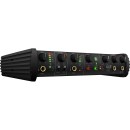
IK Multimedia AXE I/O |
VS | |
|---|---|---|
| Analog: 2 Input / 5 Output |
Channels of I/O | 1 Input / 3 Outputs at 192 kHz |
| 192 kHz / 24-Bit | Maximum Sampling Rate | 192 kHz / 24-Bit |
| 2 | Number of Microphone Inputs | 1 |
| 2x Combo XLR-1/4" TS Unbalanced Mic/Line Input 2x 1/4" TS Unbalanced Hi-Z Input 1x 1/4" TRS Headphone Output |
Analog Audio I/O |
1x Combo XLR-1/4" 3-Pin Balanced/Unbalanced Mic/Line/Hi-Z Input (Front Panel) 2x 1/4" TS Line Output 1x 1/4" TS Re-Amp Output (Front Panel) 1x 1/4" TRS Headphone Output |
| Digital Audio I/O | ||
| 1x USB-B | Host Connection | 1x USB-C (on Interface) |
| macOS 10.11 or Later Windows 8 or Later |
OS Compatibility |
Windows macOS |
| AC/DC Power Adapter (Included) | Power Requirements | USB Bus Power |
